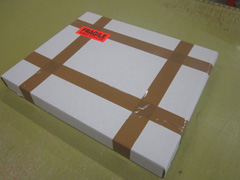| CARING FOR FINE ART PRINTS |
 |
|
Centuries ago, even decades, ago, the collection of fine art prints was primarily the purview of professional collectors alone. They would amass collections of significant prints, and keep them tightly boxed away for safety and preserving future value.
Today, however, fine art prints are popular with the everyday consumer who wants to own a piece by a favorite artist but can't afford an original. This shift in interest also means art prints are now being displayed in frames on the walls of homes, proudly and protectively, but not necessarily in a manner that will preserve them for future generations.
This article discusses the various dangers that exist for art prints, and the best way to take care of your artwork to ensure it remains in beautiful condition for as long as possible.
|
SUMMARY
The term "art print" can be understood in two different ways:
- Prints created from a digital image using Giclée inks and high quality fine art papers. Can result in an unlimited number of copies.
- Traditional "printmaking" prints, created using woodcut, etching, or screen printing methods, which are individually created but still produce multiple, nearly identical reproductions.
In this article, we will be discussing prints in general, and so covering both these styles. It is recognized, however, that traditional prints are often more valuable and possibly more sensitive since they are often produced in smaller runs and involve more human interaction in their creation.
| THE FACTORS |
STORAGE OR DISPLAY |
SAFE FRAMING PRACTICES |
TRANSPORTATION |
The primary factors of concern to art prints are: - Light
- Humidity
- Heat
- Natural Processes
|
The only way to guarantee none of these factors will damage your artwork is to store it in dedicated containers, to be removed only to show potential buyers or for shipping. If you choose to display the art, take all necessary measures to keep it as pristine as possible. |
When framing artwork, be sure to use acid-free, archival materials, separate the art from the glazing and the wooden frame, and use only reversible adhesives. |
Whenever possible, ship artwork flat, safely stored in oversized packaging to prevent damage. If you must roll the art, ensure it does not come into contact with itself. Remove art from packaging as soon as it is received. |
|
| DETRIMENTAL FACTORS
|
 |
|
There are four big factors that affect the longevity and lasting appearance of your fine art print. We will discuss each factor in its own section, looking at both the problems, and the solutions.
Art-Damaging Factors
- Light
- Humidity
- Heat
- Natural contaminants
Before we begin to look at these factors, however, let's consider one of the controversial issues surrounding fine art, both originals and prints.
|

|
| CHOOSING NOT TO HANG PRINTS
|
 |
|
You may have noticed that all the factors listed above are things that exist in our day-to-day lives. That fact can be problematic when it comes to wanting to share your art collection with visitors while at the same time longing to keep it in tip top shape for future shows or sales.
As the author of this article on caring for art prints points out, owners of fine art - prints and originals alike - must choose between whether they want to hang and admire their collected works, or store them safely out of sight, to be removed to admire only on very special occasions.
Unfortunately, the only way to ensure your art prints remain in flawless condition for generations or centuries is to keep them boxed away, securely isolated from the damaging factors inherent in open surroundings. If you decide to take this avenue, here are a few suggestions:
- Purchase a metal art storage cabinet that is deep enough for the largest print you own (or may one day own). Metal is a better choice than wood because it gives off no natural, chemical emissions that can damage the art.
- Ensure each print is kept completely separate from the others. Every paper should be stored horizontally (ie: not in a hanging file folder), within an acid-free paper or plastic folder by itself.
- Never display the artwork for more than two weeks, and only hang it in a location away from direct sunlight or constant artificial light.
- If you can't decide between framing and storage, consider purchasing a good quality reproduction of the artwork that is not signed, or handmade, or whatever the quality of your valuable print. Hang this reproduction instead, and keep your valuable print safely boxed.
|

|
| LIGHT
|
 |
|
Light is one of the most significant factors leading to the damage of fine art prints, one of the most well-known, and perhaps one of the most unfortunate. Most of us buy our art prints to show them off; it's pretty difficult to share them with your friends and family when you're worried about turning on the lights.
Most people know that sunlight can damage images on paper, often because they have seen first hand the fading and yellowing that occurs when photographs or other paper art is left in sunlight. When the paper is removed from the picture frame, often the frame opening is still visible as a lightened or discolored section bordered by the original contrast of the image. (A note about yellowing: this is a natural oxidization effect that cannot be stopped, though limiting UV rays can greatly diminish it.)
But artificial light - fluorescent and incandescent, for instance - give off small amounts of ultraviolet radiation, too. Not enough to cause a sunburn on human skin, but enough to cause those chemical reactions in paper artwork that make them change and break down over time.
Prevention
Luckily, our enjoyment of looking at art in the proper lighting has produced some quality ways to lessen or prevent the effects of UV light on printed artwork.
UV-Filtering Glazing
Today, both glass and acrylic (plexiglass) picture framing glazing can be made with UV-battling coatings or components that prevent UV radiation from permeating the glazing and reaching the artwork, without in any way hindering the viewability. If you want to keep your print in good condition while on display, UV-filtering glazing is a must. Both non-glare and regular glare styles are available on the market.
UV-Resistant Inks
Most pigment inks (those used in aqueous inkjet printers) are stable in UV light. This means they do not break down or react with UV light the same way dye-based inks do. As a result, the colors themselves should remain stable for hundreds of years. The most recent inks from Epson, for example, are tested to maintain their saturation for 200 years for color inks, and 400 years for blacks.
If you don't trust the inks or the glazing, you can always outfit your framed print with a blackout cover that is only lifted when you want to admire the piece.
|

|
| HUMIDITY AND HEAT
|
 |
Regardless of whether you choose to store or display your fine art prints, heat and humidity are important factors to consider.
HUMIDITY
If there is too much humidity in the air around your artwork, microorganisms begin to grow on the paper artwork, encouraging mold and mildew. This can result in uneven discoloration caused by breakdown of the paper, as well as brown, red, white, or blue spots developing. Any adhesives or backings will also be damaged.
Humidity-prompted bacterias and their ensuing damage can be removed and the paper somewhat restored, but the paper compounds lost cannot be replaced and less hardy papers can basically disintegrate.
If you do manage to avoid molds and other growths, humidity fluctuations can, at the very least, cause the paper to buckle or warp due to excess expansion and contraction.
Prevention
You can prevent humidity damage by maintaining a humidity level of between 40 and 60%. This shouldn't be an issue, since the recommended range for most homes is about the same.
Another easy way to prevent mold and mildew is to hang your artwork from wire rather than sawtooth or other hooks attached directly to the back of the
frame. Hanging from wire causes the frame to tilt out slightly from the wall, allowing air circulation and preventing problematic growths.
Avoid hanging important prints in the bathroom, where the humidity is often high and almost impossible to regulate. If you really want to decorate with framed pieces, consider purchasing cheap posters or low-cost reproductions. You may also want to display them in metal or inexpensive wood frames that are easy to replace should the humidity warp the wood.
HEAT
On the other side of the spectrum, too much dry heat can also cause problems for your prints. Inks can develop a sort of scaly texture if the room is too dry, and temperature spikes can cause a reddish or brown tint on the paper which often can't be salvaged and must be cut away.
Prevention
If you know your home is dry, you can purchase a humidifier, or place bowls of water on top of radiators. Whatever the conditions of your home, avoid hanging art above heated surfaces - including lamps! The most extreme fluctuations will happen here and can cause the art to dry out, making it overly delicate, resulting in crumbling. Also avoid hanging art over regular air vents.
|

|
| NATURAL FACTORS
|
 |
|
Unless your artwork was printed on 100% lignin-free paper (no wood pulp), gradual breakdown is inevitable. If any acid is present in the paper - photographic papers, for instance - colors may fade, the paper may darken and grow more fragile over time.
The only way to absolutely ensure your artwork never compromises its own structural integrity is to buy art printed on 100% cotton paper. Then, of course, you still must ensure other acidic materials don't come into contact with it when displaying or storing.
In addition to the natural growths that can develop from humidity (discussed above), check your artwork regularly for worm holes or tracks. Some bugs, specifically silverfish, can wriggle their way into the artwork and wreck havoc on the resale value, not to mention how it looks.
Tightly sealing the back of your picture frame should keep out unwanted creatures.
Though technically not a natural contaminant, remember that cigarette and other airborne smoke can cause damage to and - at the very least - a permanent odor on your special artwork.
|

|
| SAFELY FRAMING ART PRINTS
|
 |
| TRANSPORATION
|
 |
|
A big part of collecting originals and fine art prints, for many people, is the possibility of selling them for an increased price a few - or many - years later.
While this can prove a great financial boon, and is an excellent way for people to get their hands on rare prints, it also means an increase in prints damaged by incorrect or careless packaging. You might be surprised how many people charge exorbitant prices for their collected pieces, only to toss them in an envelope.
As long as the recipient is careful to remove all packaging as soon as the print is received, packaging does not have to be acid-free. It does have to be secure.
Flat Shipping
Whenever possible, ship paper prints flat (or request the collector do so). Rolling can result in bent edges and creases, not to mention a curve in the artwork that can be difficult to flatten out.
Place a protective sheet of tissue on the face of the artwork, or insert it into a clean glassine or paper folder. Very rigid, flat material - such as corrugated cardboard or plastic - is then used to sandwich the art, allowing an inch or so of space between the edge of the artwork and the edge of the cardboard. For extra protection, affix photo corners to the cardboard to hold the artwork in the center.
Carefully tape or wrap the sandwich so it is held tightly, and either place it in a box, or wrap it with bubble wrap or foam and slip it into an envelope. You can label the package "Fragile", but don't rely on this notation to make up for shoddy packaging.
Roll Shipping
If you must roll the artwork, place it first between two sheets of protective tissue, so no part of the print touches another part. Wrap the rolled tube in a piece of paper and tape this paper down so the art does not unroll inside the cardboard tube. It might be a good idea to wrap the artwork in a sheet of paper that is wider than the art, to prevent the edges from crumpling due to banging against the ends of the tube.
As soon as any art print is received, it should be removed from the shipping package and either framed or stored following acid-free, archival methods.
|

|
|
If you're looking for more in-depth information on repairing or patching up existing damages to your fine art prints, the article Restoring Prints has some professional tips on removing damaging compounds from paper prints, from pencil to blood.
If you have questions about the qualities of our fine art prints, or any of our services or products, don't hesitate to contact us. Our knowledgeable staff is always happy to assist with answers, advice, or suggestions.
|
|
© 2002-2026 - KeenART Media Ltd.
|
|
| |
|

